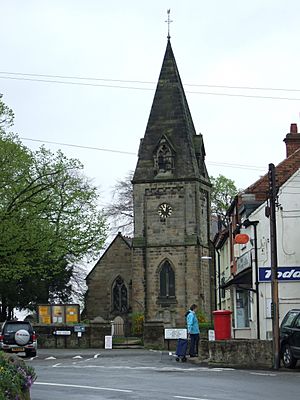Benjamin Robinson facts for kids
Quick facts for kids
Benjamin Robinson
|
|
|---|---|

His first church in Findern (today)
|
|
| Born | 1666 Derby, Derbyshire
|
| Died | 1724 |
| Education | Sheriff Hales, Shropshire |
| Occupation | Presbyterian minister |
| Spouse(s) | Anne |
| Children | several |
Benjamin Robinson (born 1666, died 1724) was an important English church leader. He was a Presbyterian minister, which means he was a type of Christian pastor. Benjamin was born in Derby, England. He became a very respected thinker about religious topics and even published his ideas. He also started a school in Findern, a village in Derbyshire.
Contents
Benjamin's Early Life and Education
Benjamin Robinson studied to become a minister with John Woodhouse in Sheriff Hales, Shropshire. He started his career working for important families. First, he was a chaplain and teacher for Sir John Gell at Hopton, Derbyshire. Later, he worked for Samuel Saunders in Normanton.
After Samuel Saunders passed away, Benjamin got married. He then became the Presbyterian minister in Findern, Derbyshire. He was officially made a minister on October 10, 1688.
Starting Schools and Helping Students
In 1693, Benjamin Robinson opened a school in Findern. This was a bit unusual at the time, and he was called to court by the bishop. However, Benjamin knew William Lloyd, who was the bishop of Coventry and Lichfield. Benjamin talked to the bishop, who stopped the legal action. They even stayed up late talking about different religious views and later wrote letters to each other.
Later in 1693, Benjamin moved to Hungerford, Berkshire, to lead a church there. He was recommended by John Howe, another important religious leader. In 1696, Benjamin started another school in Hungerford. This school grew into a special academy that trained new ministers. The Presbyterian fund even sent students to him. Benjamin wanted to teach his students good values and encourage them to love learning.
Gilbert Burnet, who was the Bishop of Salisbury, visited Hungerford and met Benjamin. Benjamin explained his work, and they became friends. Benjamin and another minister, Edmund Calamy, met with Bishop Burnet several times in 1702 to discuss matters important to nonconformist Christians. People said Benjamin could get more done in an hour than others could in a whole day!
Life in London and Later Years
In 1700, Benjamin Robinson took over from his old teacher, John Woodhouse, as the Presbyterian minister at Little St. Helen's in Bishopsgate Street in the City of London. He became very popular as a preacher because he was a natural speaker and could write quickly and powerfully.
In 1705, he also became one of the main speakers at the Salters' Hall lectures. This became his most important work as his health began to decline, and he had to do less.
Benjamin Robinson passed away on April 30, 1724. He was buried in Bunhill Fields, a famous burial ground in London. He left behind his wife, Anne, and several children.
Benjamin Robinson's Published Works
Benjamin Robinson wrote several important books and papers during his life. Here are some of his major works:
- A Plea for ... Mr. Baxter in answer to Mr. Lobb, published in 1697. This book defended the religious ideas of another important thinker, Mr. Baxter.
- A Review of the Case of Liturgies, published in 1710.
- A Letter ... in defence of the Review, also published in 1710. Both of these books were written in response to another writer, Thomas Bennet.
- 'The Question stated, and the Scripture Evidence of the Trinity proposed,' published in 1719. This was part of a larger work about the Christian idea of the Trinity.

